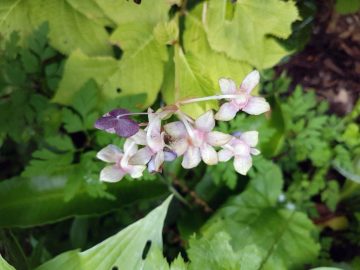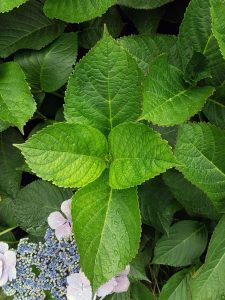
Hydrangea macrophylla ‘Mariesii Perfecta’
A summertime visit to the Botanical Garden is a singular pleasure. When the temperatures finally rise to something resembling summer heat (hopefully this will happen in July), the forested paths of the woodland areas of the Garden beckon visitors to enjoy a cool respite from the sun. It’s easy to while away the hours sitting on a bench by a pond watching the antics of birds and dragonflies. In the shade of the David C. Lam Asian Garden, cranesbills (Geranium), astilbes (Astilbe), rodgersias (Rodgersia) and fairy wings (Epimedium) fill gaps between rhododendrons, deciduous trees and tall conifers. Rhododendrons are seldom thought of as summer bloomers, but the Garden has a number of July-flowering species, including the iconic Rhododendron auriculatum, with its long leaves, auriculate (ear-like) leaf bases, and sticky, fabulously-sweetly-scented, white or pink trumpet-like flowers that emerge in late July (south end of Wharton Glade). Somewhat earlier is another Chinese species, the equally impressive and even more tree-like Rhododendron glanduliferum (scattered plantings along Lower Asian Way from Purdom Trail to Kingdon Ward Way) with its oil-of-wintergreen-scented flowers.
Hydrangeas, much valued for their summer-borne blooms, are in evidence in the Carolinian Forest Garden, Contemporary Garden and Asian Garden. The Botanical Garden has some 160 different hydrangeas and hydrangea relatives in its collections. The family, Hydrangeaceae, which includes trees, shrubs, climbers and herbaceous perennials, is characterized by shade tolerant plants, though there are a few notable exceptions. The bush anemone, Carpenteria californica, a prominent shrub in the North American section of the E. H. Lohbrunner Alpine Garden, for example, displays its huge pure white blooms in late June and July at UBC.
The Contemporary Garden is home to a significant collection of Hydrangea macrophylla (common hydrangea) cultivars on the north side of the Arbor. Prominent among them is the ever-popular Hydrangea macrophylla ‘Mariesii Perfecta’ (blue wave hydrangea). Although still small, a good number of newer additions are starting to flower. Some 50 different, primarily “mop-head” cultivars—a gift of the local hydrangea nursery, Heritage Hydrangeas, in memory of its owner, Barry Roberts—will provide summer colour for years to come.
Climbers assigned to the genus Hydrangea include both evergreen and deciduous species—most of them white-flowered, but all of them handsome (notwithstanding the recent freeze damage to a couple of evergreen species). The “wood vamp,” Hydrangea barbara (previously known as Decumaria barbara), is an eastern North American “self-sticking” deciduous climber that produces its flowers in July. Look for it on trees throughout the Carolinian Forest plantings, though the largest is plastered to the north side of a black walnut, Juglans nigra, in Catesby Grove. Plantings of the oakleaf hydrangea, Hydrangea quercifolia and silverleaf hydrangea, Hydrangea radiata are in the Carolinian, as well, and blooming at either end of Fraser Grove. At a somewhat grander scale, Hydrangea hydrangeoides (formerly Schizophragma hydrangeoides) ascends trees in the Asian Garden and also blooms in July. There are several plantings throughout the Garden, but the specimen on Upper Asian Way near Wharton Trail is truly impressive.
Herbaceous hydrangeas include species previously known under the name Dienanthe. A lovely patch of the low, pale-blue-flowered Hydrangea caerulea can be found in the Asian woodland section of the Alpine Garden. The closely related Hydrangea bifida, with lighter-coloured flowers, is given somewhat more space in the Asian Garden (around where Straley crosses Campbell Trail). Both are readily recognized by their unusual-looking bilobed leaves. The most impressive of the herbaceous hydrangea relatives is arguably the East Asian Kirengeshoma palmata. Japanese seedlings grow to about 1.5 m (5 feet), while our more robust Korean collections top out at more than 2.5 m (8 feet). Two plantings (the Japanese and Korean) face each other across Upper Asian Way just short of Straley Trail. The stems on both types carry opposite pairs of broad, jagged-edged leaves and are surmounted by waxy, tubular yellow flowers that dangle on wire-like stems. The flowers and are visited by all manner of bees, butterflies and hummingbirds, and admired by all who see them.
- Rhododendron glanduliferum
- Rhododendron glanduliferum
- Rhododendron glanduliferum
- Rhododendron auriculatum
- Kirengeshoma palmata
- Kirengeshoma palmata
- Hydrangea radiata
- Hydrangea radiata
- Hydrangea radiata
- Hydrangea bifida
- Hydrangea bifida
- Hydrangea caerulea
- Hydrangea caerulea
- Hydrangea macrophylla ‘Mariesii Perfecta’
- Hydrangea macrophylla ‘Mariesii Perfecta’
Submitted by: Douglas Justice, Associate Director, Horticulture and Collections















